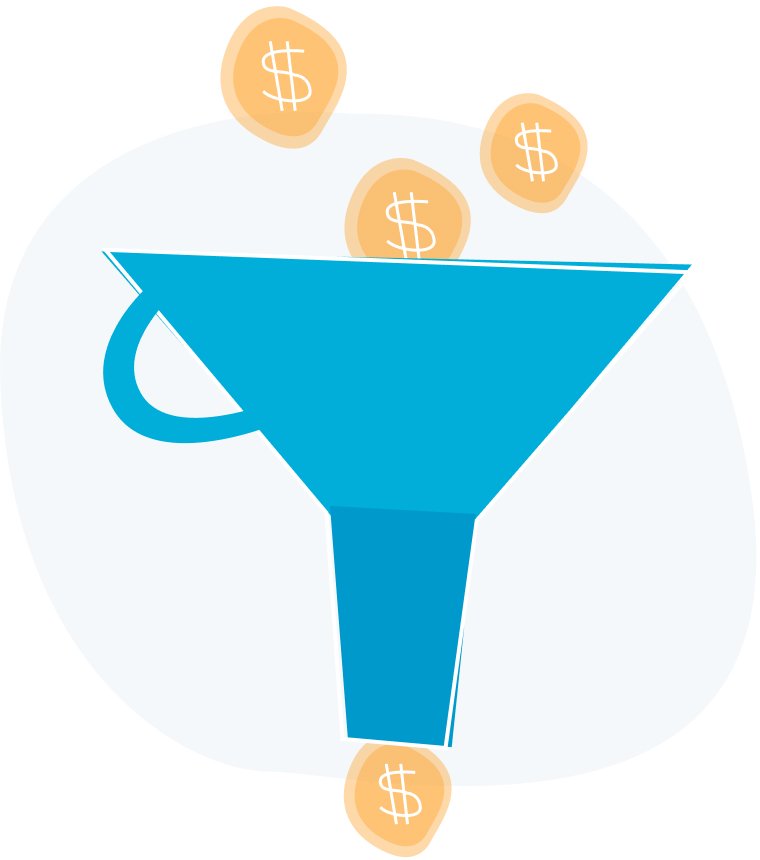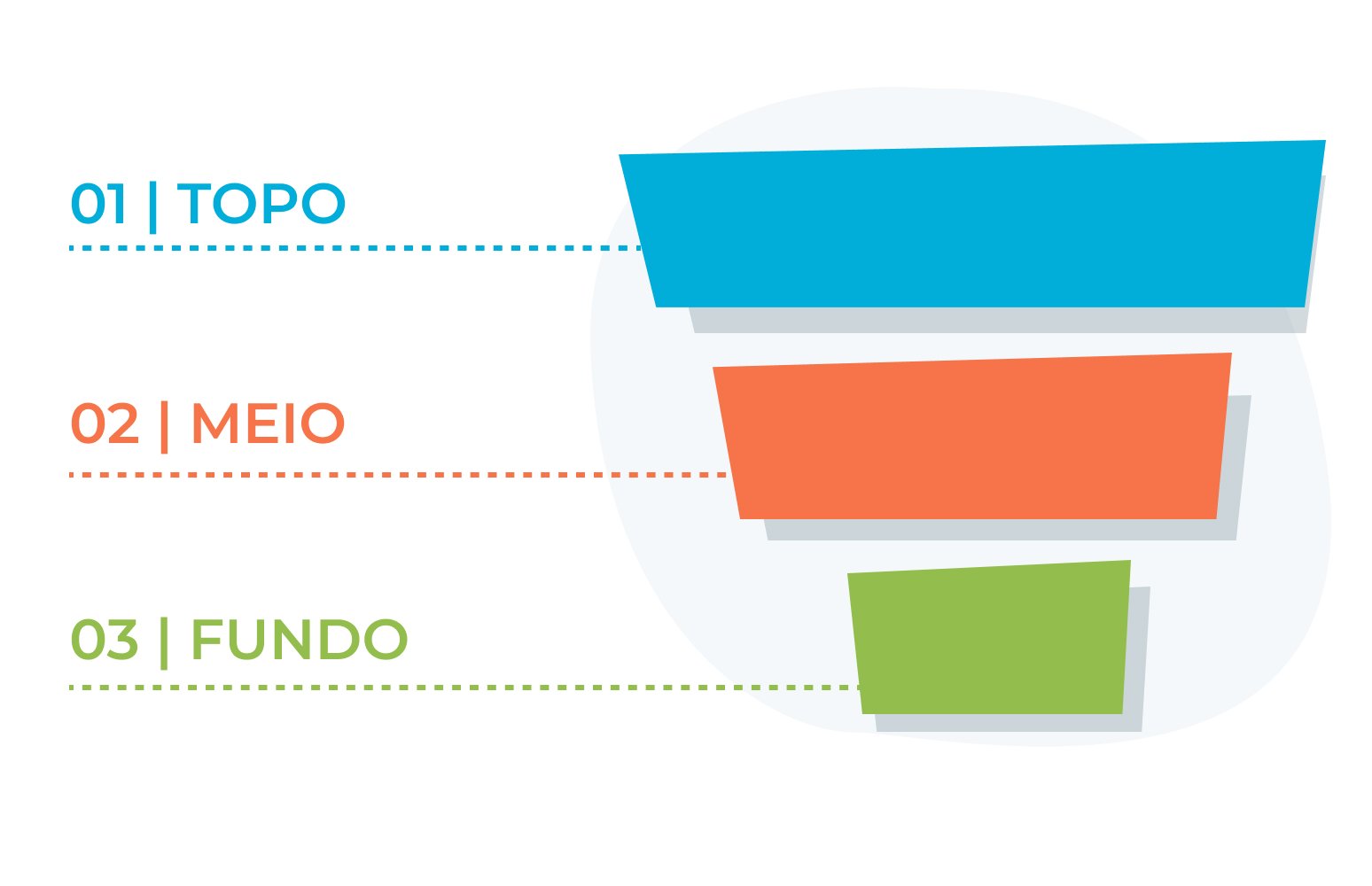Do you know the importance of a sales funnel? In this post, we´ll cover what a sales funnel is, how you can apply it, and we´ll come up with some tips on how to measure your results. Check out!
A lot is said about sales funnel on the internet, but the fact is that few understand the real concept or apply the right way.
A good sales funnel a set of steps that support the public interested in a company’s products and services to go through their shopping journey and become customers of the company that applies it.
Such a well-implemented sales funnel able to make the sales process of an organization somewhat automated and mostly scalable, where you have to insert more people into this funnel so that the number of customers is increased significantly.
This sales funnel still has the power to lead people into their buying journeys, often informing and making consumers aware of problems and solutions that they would never have imagined before contacting the company.
The key to the whole essence of this type of strategy is two simple words: Transformation and Relationship.
This is due to the fact that through a sales funnel companies and or entrepreneurs can turn people who often do not even know of the existence of a need for a particular product or service on customers.
For example, let’s imagine a person suffering from stress. Many times she does not even suspect that Yoga is the solution to the problem. Alternatively, yet, she often suffers from stress without even knowing what she has.
This kind of processing can be done very well through a well-executed sales funnel.
Contents
But why is the Sales Funnel a much more effective Digital Marketing strategy?
Some time ago, where Digital Marketing strategies were much less evolved, many companies believed that it was enough to create websites or create blogs to have a result through the internet.
Creating a website and using ads to draw people into these pages may even generate some results, but that is not enough to automate the sales process, let alone transform people.
This is because through Marketing it is possible to understand that every consumer has his or her day of purchase.
In other words, many consumers who are accessing your pages are not ready to buy. Possibly a good part of these consumers will be ready to buy within a period of time, but at the moment of access, they are not yet able to make the purchase.
By imagining the traditional “disclosure” model where ads are made, the vast majority of people leave their pages without making the purchase simply because they are still researching the solutions and are not able to buy.
This makes your actions much less effective. To better understand what we are saying, it is important to know better the concepts of Consumer Type and Sales Days, which we will cover in the next topics.
Types of Consumer in a Sales Process | Consumer Day
There are 5 large groups of consumers when we think of Digital Marketing, the quiet, the bothered, the researchers, the comparators and the buyers.
Of course, buyers are always the smallest group of five. It is worth remembering that the same consumer goes through the 5 stages in a traditional buying process. The time a consumer takes at each stage varies from case to case, and it is impossible to pre-determine.
1. Quiet:
This is a typical case of the type of consumer found most often in some business segments. It is the stage where the consumer is not yet aware of the problem.
A classic example is a consumer who suffers from stress and does not yet know that Yoga is one of the possibilities of solving their problem. To reach this type of consumer and make him enter the funnel, is to make him aware that there is a problem.
2. Troubled:
The second step in the journey of buying a consumer, the troubled are the consumers who became aware of a problem but have not yet been looking for solutions or how to solve it.
At the moment, this consumer coexists with the problem. In many cases, where a strategy is well executed, the consumer moves from the quiet to the researcher in an almost instantaneous way, because the degree of impact is so high that the urgency to solve the problem becomes almost immediate.
3. Researchers:
It is the first stage of a potential consumer. When every person wants to get a product, the first step in the buying process is to research the product of desire.
Let’s imagine an example. Imagine you want to buy some tennis on the internet.
The first step of your buying process is to access Google or another search tool and start searching for the models and colors available in the market. At the moment, you are a consumer researcher, that is, you are interested in the product but will not affect a purchase on the spot, because you know the options that exist in the market.
4. Comparators:
After researching and knowing all the tennis options that exist in the market, surely you have already identified 1 or more models that you are interested in buying, that satisfy you and fit your budget.
Now start comparing the stores that offer this product that you liked to see the one that offers the best Buy conditions, price, term, bonuses and so on.
At the moment, it stopped being a consumer researcher to be a consumer comparator. You are moving forward in the buying process.
5. Buyers:
Once you have understood the conditions offered in the market, you will be able to purchase your product. Just find a supplier that offers a better condition. If in your search you find a supplier capable of offering the best condition among everything you have ever compared, you will be fully able to make the purchase.
At the moment, it is no longer a consumer comparator to be a consumer buyer.
Note that in the evolution of the sales process, many people gave up and left this cycle. This is because many do not find suitable solutions, others do not find solutions that are financially viable, and others directly entered this cycle out of curiosity.
Because of this, the group of consumer buyers is always much smaller than the other groups.
When we imagine the traditional model of sales on the Internet, where companies create pages and advertise to bring those interested to those same pages, they invest in bringing consumers researchers and comparators, that is, the vast majority of these people are not able to buy.
Also, a web page is very “cold” and very difficult to “hold” people with the company, causing there to be a tremendous loss of investment.
Another negative point is that in this case, companies can only attract people who have already identified that they have a problem or a need and are looking for a solution.
How the Sales Funnel Works in Practice
We have already talked so much about this Digital Marketing strategy in a conceptual way, and until now you may not have been able to contextualize all this if you are having the first contact with this strategy now.
A sales funnel can be better understood through the image below that demonstrates its steps:
Funnel top:
This stage is where attraction occurs. It consists of attracting people to start a relationship with the company or the entrepreneur.
Through a Landing Page, the company offers a gift, known as Digital Reward or Digital Bait, which is nothing more than delivering something of value to the target audience for free or next.
This causes people to arouse interest and sign up to receive the reward. At this point, people have just entered the funnel and go to step 2, the middle of the funnel.
It is crucial to get people to this capture page. Ads are usually used. Mostly persuasive ads that arouse the interest of the people you crave.
At this moment, to arouse interest, it is essential that an advertisement is quickly demonstrated that will change when you solve the problem or the problem you will have if it does not resolve.
To be effective, your ad needs to have a purely emotional proposition. That is, nothing to announce your solution technically.
Remember the example of Coca-Cola’s marketing strategy. She sells bottled syrup or sells “happiness” or “a nice family lunch on Sunday.” It’s purely emotional.
Sales Funnel Medium:
At this moment, a relationship between the company and consumers is initiated through the application of Email Marketing and Content Marketing strategies.
The company through the delivery of content through Email Marketing makes consumers understand that they actually have a problem and mainly presents its solution as the best for the problem that it has.
This stage is the main one within a sales funnel because it is here that companies make the Shopping Journey occur for these consumers.
In the example, we mentioned in Yoga, at this stage it is time to show that stress is the reason for all the problems that the consumer has, such as back pain, migraines, sleep problems, among others.
Also, especially then show that Yoga is the best solution for fighting stress (there are other solutions).
Funnel Bottom:
Now that the consumer already knows they have a problem and that their solution is the best for their problem, it is time to present the “Irresistible Offer.”
It consists of reaching out to your consumers and presenting a very value-added offering that will convert the highest possible percentage of consumers who find themselves in the middle of the funnel into actual customers.
Email Marketing in a Sales Funnel
Email Marketing is fundamental for a sales funnel to exist. It’s the only way to engage with consumers effectively.
By imagining in a traditional sales model, before the existence of strategies as a sales funnel, companies invested high values in consumer-sponsored link ads that did not buy their products just because they were still the types of consumer researchers or comparators.
About 99% of the people who arrive at product and service pages in this way leave without making the purchase.
The sales funnel makes it much more effective because it is possible to capture 40%, 50% and in some cases even more emails from people who have accessed the page, to start a transformation relationship that aims to become real customers.
Also, all this transformation is done via Email Marketing, after registering people in a list through a digital reward.
Because of this, finding a partner such as E-goi is essential if your strategy is to succeed, as well as having efficient support for the quality of e-mail delivery is a critical factor in making the results compelling.
How much is it possible to increase billing with a Sales Hopper?
This type of data suffers from segment to segment. It is difficult to state a precise number.
What we can say is that we already participated in projects where we increased the sales of 1% of the public who accessed the page to 5, 6, or even 7%.
That means a 7x increase in sales using the same investment by acquiring traffic through sponsored links. That is an absolute success.
We hope this article can help you with your Digital Marketing strategies.

